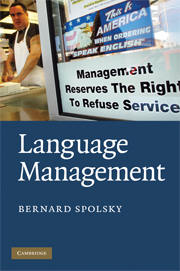Book contents
- Frontmatter
- Contents
- Acknowledgements
- 1 Towards a theory of language management
- 2 Managing language in the family
- 3 Religious language policy
- 4 Language management in the workplace: managing business language
- 5 Managing public linguistic space
- 6 Language policy in schools
- 7 Managing language in legal and health institutions
- 8 Managing military language
- 9 Local, regional, and national governments managing languages
- 10 Influencing language management: language activist groups
- 11 Managing languages at the supranational level
- 12 Language managers, language management agencies and academies, and their work
- 13 A theory of language management: postscript or prolegomena
- References
- Index
5 - Managing public linguistic space
Published online by Cambridge University Press: 05 June 2012
- Frontmatter
- Contents
- Acknowledgements
- 1 Towards a theory of language management
- 2 Managing language in the family
- 3 Religious language policy
- 4 Language management in the workplace: managing business language
- 5 Managing public linguistic space
- 6 Language policy in schools
- 7 Managing language in legal and health institutions
- 8 Managing military language
- 9 Local, regional, and national governments managing languages
- 10 Influencing language management: language activist groups
- 11 Managing languages at the supranational level
- 12 Language managers, language management agencies and academies, and their work
- 13 A theory of language management: postscript or prolegomena
- References
- Index
Summary
Public linguistic space
In our own homes, with some exceptions, members of a family expect to have control over linguistic space. If there are notes left by the telephone, we decide what language to write them in; we choose the books for the bookshelves and the newspapers to litter the living room; we select or veto a television channel; and as was discussed in chapter 2, we have our own way of influencing what languages should be spoken among family members and when. When we leave home and enter someone else's space, we recognize that the owner can decide on these matters. In churches, synagogues, and mosques, we acknowledge the authority of priests, rabbis, and imams. In commercial enterprises, while we are most likely to patronize those businesses which make provision for our language preferences (“English spoken here”), we know that the owners of the business are generally in charge. Thus, we know and understand the rules for private and institutional space. In this chapter, I want to focus on public linguistic space – the language policy of areas of our mainly urban and generally built up or developed environment – the city streets and squares, roads and parks, railway and bus stations and stops – all places which are neither private nor institutional. Public linguistic space may include written material (public signs, newspapers and magazines, books), spoken content (announcements, radio, or television), or computers and the Internet.
- Type
- Chapter
- Information
- Language Management , pp. 65 - 89Publisher: Cambridge University PressPrint publication year: 2009



